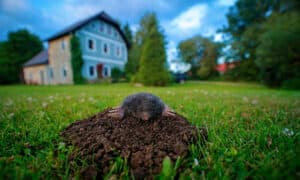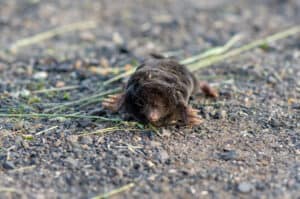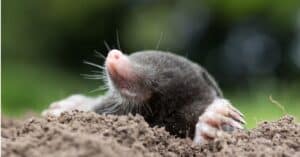The names rhyme and their similar behavior can lead to serious property damage. At the end of the day, voles and moles are actually quite different creatures.
Both are small animals and, if left unattended, will destroy garden plants and lawns. And they’ll do so almost invisibly with uninformed property owners not discovering the attacks until it’s too late! It’s a good idea to have an understanding of these two animals and their behavior to detect their presence. So let’s explore voles versus moles!
Why Voles and Moles Are Harmful?
Voles prefer to chomp on plants and tree bark. Moles nibble on insects and anything else that moves. It’s their digging that destroys the surfaces of your turf, leaving behind unseemly holes and mounds. Moles leave damage to grass and garden plants. There’s also the risk of gaping holes that humans can step into.
Voles eat your vegetation, damage the root systems of plants. Moles burrow into the soil all year-round, looking for earthworms and other life to feed on. Voles look for snowpacks during the winter for safety in the cold. After the snow melts, the critters leave worn, obvious tracks in lawns that may be irreversible.
Comparing Vole vs Mole
Let’s take a look at some of the differences between these animals in terms of appearance, behavior, and other factors.
| Moles | Voles | |
|---|---|---|
| Moles are not rodents. They’re insectivores and spend their entire lives underground. In their search for food, they shred suburban gardens and lawns. | Voles are small rodents. You can find voles above ground but they’ll dig several burrows for protection and shelter. They populate quickly with a density capacity of 2,000 voles per acre. | |
| Appearance | Moles are small and live a subterranean lifestyle. Their bodies are cylindrical with velvety fur. They have short, powerful forelimbs, large paws, reduced hindlimbs, and tiny, inconspicuous eyes and ears. | A member of the hamster and lemmings family, voles are small rodents with stout bodies, hairy, short tails, smaller ears and eyes, and a slightly round head. |
| Size & Weight | A mole can grow to 4.5 inches and weigh about 1.7 ounces. | A vole can grow to 4.5 inches and weigh around 0.95 ounces. |
| Behavior | Moles only come out when they find food, poking out long enough to attack grass, plants, flowers, etc. | Voles are year-round, day and night, creatures. They feed on grass, bulbs, herbaceous plants, tubers, bark, and tree roots. They store plant matter underground. |
| Environment | Living underground, the mole looks for grasslands, meadows, wetlands, and riparian habitats. | Voles love grassy and weedy areas with heavy ground cover. They also take refuge in pond and stream banks, orchards, hayfields, and pastures. |
The 7 Key Differences Between Moles and Voles
Here are significant traits about the mole and the vole that distinguishes the two creatures.
1. Vole vs Mole: They Are Not of the Same Species
Voles are rodents and moles are not. Voles are members of the Mammalia class, the Rodentia order, and the Cricetidae family. They are relatives of lemmings and hamsters. Moles are mammals in the Talpidae family, classified as Mammalia of the Eulipotyphia order.
2. Vole vs Mole: Diet
Voles stick to plant life. Their diet consists of grasses, tubers, bulbs, and a variety of plants. Some even eat tree bark and roots. Occasionally, they will horde plant matter underground to store for winter.
Predatory moles are in the market for grubs, insects, and worms, and slugs. They throw in the occasional plant as well. Moles can easily consume their bodyweight each day. This fuels their tunnel building.
3. Vole vs Mole: Unique Work
Moles are probably in the vicinity if there are furrows of soil on your property. Voles eat plants but do not burrow like the underground mole. Voles eat grass, flower roots, bulbs, and seeds. If food is scarce, they’ll chow on tree bark and shrubs. If you have raised tunnels in your yard, it’s most likely moles. If you have entry holes that lead to underground tunnels, voles may be the culprits.
4. Vole vs Mole: Distinct Appearances
Voles are often mistaken for house mice. But the vole has a shorter tail. Moles have tails as long as their bodies. Certain moles also have star-like protrusions on their face that act as eyes when pressed to the soil. The protrusions give them a “view” of their surroundings as if they could see.
5. Vole vs Mole: Reproduction
Like mice, voles quickly reproduce. Inside of weeks, a vole family can triple in size. They produce litters anywhere between five and 10 times during the year. Moles breed only once a year and their litter is usually two to six pups (as they’re called).
6. Vole vs Mole: Lifestyles
Moles are predatory and do their dirty work below ground surfaces. Once they find sufficient feed, they stick around. Voles live in creeping or low-lying vegetation. They leave trails through grass and snow. Voles are herbivores and go after your seeds, bulbs, and roots.
7. Vole vs Mole: Survival Mode
The mole’s eyes are so small you can’t see them. They’re colorblind and can only detect movement and light. They keep still and use sensors at the tip of their noses to locate scents of prey and other moles. Voles have poor vision too and use their body shape and claws for navigation.
Summary: Moles vs Voles
| Characteristic | Moles | Voles |
|---|---|---|
| Taxonomy | Class Mammalia Order Eulipotyphia Family Talpidae | Class Mammalia Order Rodenta Family Cricetidae |
| Diet | Omnivores | Herbivores |
| Behavior | Raised tunnels, visible | Holes to underground tunnels |
| Anatomy | Tail as long as body Star snout | Resemble house mice Shorter tail |
| Reproduction | Breed annually 2-6 pups/litter | Breed constantly 5-10 litters/year |
| Lifestyle | Predators Stay when find food | Herbivores Forage for bulbs, roots, seeds |
| Survival | Use nose sensors to detect surroundings Only detect light with small eyes | Poor vision Body & claws made for navigation |
Voles vs Mice
Voles and mice are often confused for each other, and rightly so. Both animals are 5-8 inches long with grey-brown fur. Telling these two apart requires getting a good look at the animal. Voles are stockier than mice with smaller eyes and shorter tails. Mice have more prominent ears than voles. Both are capable of getting into your home but voles prefer outdoor areas where they can burrow, looking for plant bulbs, roots, and seeds.
Up Next…
Animals like moles and voles that burrow into your garden and destroy your plants. Here are several ways to deter pests such as these:
- The Top Ultrasonic Snake, Rodent, and Garden Pest Repellent – Chemical Free for 2022! – Using chemical pest control can affect animal populations and ruin your plants, so try out this chemical-free pest control option!
- The Best Deer Fence To Protect Your Garden – Deer are another pesky animal that love to snack on yummy garden produce. Keep them out with this deer fence.
- 7 Best Ways To Keep Rabbits Out Of Your Garden – It’s always special to see a rabbit in the wild, but if they’re hanging around your garden it may be bad news for your crops.
The photo featured at the top of this post is ©
FAQs (Frequently Asked Questions)
How do you tell if you have moles or voles?
Moles are carnivores but in their constant search for food, they leave a lot of damage in their wake. It’s the constant burrowing that reveals the creature’s presence. Voles dig as well but you’ll see their work in the destruction of your garden and lawns.
What attracts voles to your yard?
Voles love ample vegetation, tall grass, and weeds. These elements make excellent cover and food.
What attracts moles?
Moles are constantly looking for food. If they find some, they’ll stick around, leaving mounds, tunnels, and holes everywhere. In their fervor, they detach plant roots, kill plants, trees, and lawns, and promote the growth of weeds.
How do I get rid of voles in my yard?
You can take natural steps such as eliminating what attracts them in the first place. Mow lawns regularly. Remove brush, shrubs, and low-lying bushes. If they are already ingrained in your ecosystems, you may need to hire a professional exterminator.
How do I get rid of moles on my property?
Eliminate food sources such as lawn insects, grubs, ants, mole crickets. As moles like damp soil, avoid overwatering your property. They only need one inch of water to make themselves at home. There are also repellants, baits, and traps you can deploy. If their presence cannot be controlled, call a professional.
Are voles and moles bad?
They are significant threats, wreaking continuous havoc on your ecosystem.
Thank you for reading! Have some feedback for us? Contact the AZ Animals editorial team.






